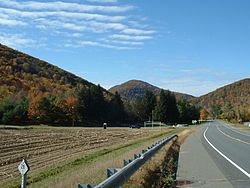Mohawk Trail
|
Mohawk Trail
|
|

The Mohawk Trail, with Todd Mountain in the background
|
|
| Nearest city | Greenfield and North Adams, Massachusetts |
|---|---|
| Coordinates | 42°38′27″N 72°57′13″W / 42.64083°N 72.95361°WCoordinates: 42°38′27″N 72°57′13″W / 42.64083°N 72.95361°W |
| Area | 2,275 acres (921 ha) |
| NRHP Reference # | |
| Added to NRHP | April 03, 1973 |
The Mohawk Trail began as a Native American trade route which connected Atlantic tribes with tribes in Upstate New York and beyond. It followed the Millers River, Deerfield River and crossed the Hoosac Range, in the area that is now northwestern Massachusetts.
Today the Mohawk Trail is a part of Routes 2 and 2A. It follows much of the original Indian trail, from Athol, Massachusetts to Williamstown, Massachusetts, for about 69 miles (111 km), and passes through the communities of Orange, Erving, Gill, Greenfield, Shelburne, Buckland, Charlemont, Florida, and North Adams. The Berkshire mountains are clearly visible from several points. The modern day Mohawk Trail is considered one of the most beautiful drives in Massachusetts. There are numerous points of interest along the way, including many scenic viewpoints, roadside attractions and gift shops. Of particular note is the Hail To The Sunrise Statue at Mohawk Park, which features a tribute to Native American heritage. A portion of the trail parallels the Deerfield River for several miles, and passes through the village of Shelburne Falls, and the Bridge of Flowers. The route crosses the Connecticut River via the historic French King Bridge at a height of 140 feet. The road reaches a high elevation of 2272 feet at Whitcomb Summit. On the western side of the summit there is the popular hairpin turn and lookout, overlooking the city of North Adams and the Taconic Mountains. On the eastern side, the highway descends steeply eastward from Whitcomb Summit down the slope of the Hoosac Range following the Cold River to the Deerfield River. Notable features include the infamous Dead Man’s Curve.
...
Wikipedia

